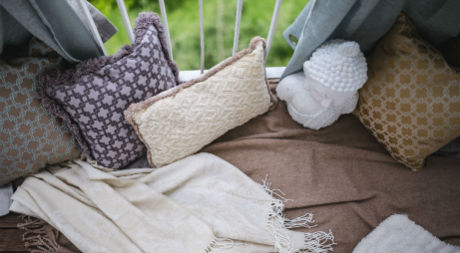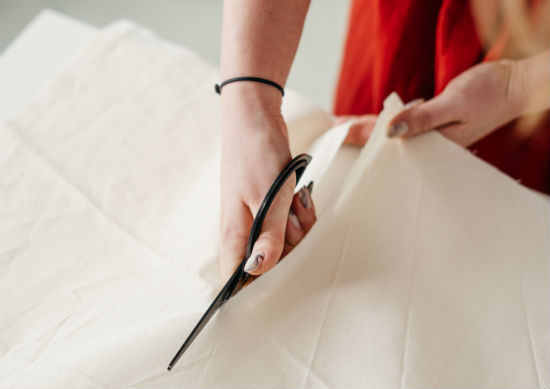Viscose and Cotton lead the pack in terms of affordable high-quality fabrics. They possess excellent intrinsic characteristics, and they bring to the table a new and unique feature.
So we decided to write this article to ask a simple question, Viscose vs Cotton: what are the differences and which one is better? And what about Viscose Cotton Blend?
Let’s see how both of these eco-friendly options compare in terms of durability, price, breathability, warmth, and stretchiness. Plus, we’ll be finding out which material is more suitable for dresses, shirts, leggings, bed sheets and comforters. Let’s go green!
COTTON
- Soft texture
- Natural fabric
- Highly biodegradable
- Can get pricey (Egyptian cotton)
- Breathable
Viscose or Cotton? Differences & Similarities
The textile industry is arguably one of the most important pillars of our global economy, producing the clothes we wear and the bedding we sleep on.
Both Viscose and Cotton are biodegradable fabrics that sync perfectly with current eco trends, and even though they are generally pricier than their synthetic and semi-synthetic counterparts, the increase in value is demonstrated by both of these product’s intrinsic characteristics.
Viscose is a type of Rayon fabric that is made with dissolved wood pulp or agricultural byproducts, later reconstituted as cellulose fiber.
Viscose differs from Rayon because the term “Viscose “ is used for wood pulp cellulose fiber, while the term “Rayon” is used when the raw materials come from other agricultural sources, a very popular one being bamboo.
Viscose is often referred to as “Synthetic Cotton”
…and it was invented precisely to nullify the wrinkles one would usually find in Cotton fabrics.
Cotton, on the other hand, is a naturally occurring fiber that grows outside the plant’s protective seed casing.
The plant is a perennial of the genus Gossypium, usually harvested annually due to pest control. It is the most widely used natural fiber in the world and is known for its high quality and durable characteristics. It’s even called the king of fabrics.
It can withstand high moisture absorption if truth be told, it actually increases its strength when wet, making it perfect for damp environments and continuous washing cycles.
It’s also a sustainable source of fiber, especially if grown organically, making its production highly self-sufficient and eco-friendly.
Feel
Both of these fabrics have a very similar texture and feel, nevertheless, Viscose is usually a bit silkier and smoother to touch, drape, and sleep on.
Price
Cotton, especially Egyptian and Pima cotton is much more expensive than Viscose, doubling or even tripling the average price.
When sourcing for organic Cotton, the price may increase as much as 3 times compared to regular Cotton. If your wallet allows it, and you feel committed to the environment or just looove the luxurious feel it gives, Cotton is here to save the day.
Breathability
Viscose is essentially a semi-synthetic fabric made from processed wood pulp like bamboo or eucalyptus.
This makes it less permeable and breezier than Cotton. Cotton is by far one of (if not) the best fabric out there in terms of breathability.
A Cotton shirt and shorts are the perfect outerwear for warm, sunny days.
Uses
Cotton is used to produce almost anything textile-related, either directly, or blended with other materials. You can find it in many t-shirts, formal wear, blue jeans, socks, towels, table cloths, cleaning cloths, and even mattresses.
Viscose possesses slightly silkier characteristics and is used when making dresses, carpets, skirts, bed sheets, scarfs, blankets, mantles.
Viscose is also regularly blended with other fabrics, making it usable for the same applications as the Cotton blend would.
Durability
Cotton is considered more durable, it doesn’t tear, shrink, or stretch, as much as Viscose. Cotton’s role as an essential kitchen cloth is proof of its reliability.
Also, remember that one blue jean you wore for a good decade? Yes, we also remember.
Warmth
Even though Cotton is well suited to help you stay warm during a mild spring day, Viscose lower breathability offers better insulation during winter, as it is more efficient at trapping hot air for longer.
Washing and Drying
Cotton’s airy nature and excellent water-absorbent properties make it one of the most durable, and reliable fabrics.
Viscose suffers from very low elastic recovery, meaning it stretches, shrinks, and deforms after washing.
Ironing is recommended for both fabrics to maintain all their best qualities. It is advisable, however, that you always Iron Viscose fabrics after washing.
Viscose Cotton Blend Characteristics
Combining both of these fabrics appealing features, Viscose Cotton Blend is an excellent material for any type of clothing.
It synergizes their essential character, breathability, strength, silky feel, ease of draping around the body, durability.
Viscose Cotton Blend is also much cheaper than Egyptian or Pima Cotton. If you are looking for fashionable clothing that feels soft, strong, and airy then congrats, you have just found it.
Are Viscose and Cotton Stretchy?
Both of these fibers are moderately stretchy, yet they differ in terms of how much you can stretch them before they visibly deteriorate.
Cotton has the advantage in terms of preserving its shape and strength, while Viscose low elastic recovery makes it a material that requires a bit of extra attention.
Try wearing a newly washed Viscose shirt without ironing it first and you’ll see what we mean.
Viscose vs Cotton Bed Sheets: Which Ones Are Better?

If you are sleeping in warm weather, anything that helps keep fresh comes in handy, which is why conventional Cotton bed sheets and comforters can help in keeping those passions from burning too hot.
Viscose vs Cotton Dress

Go for Viscose. Cotton dresses, on the other hand, are much more reliable for daily use.
They aren’t as classy usually, but they will guarantee you airy comfort and durability.
What’s Better – Viscose or Cotton Shirt?

Cotton is the most common fabric found on shirts around the world.
Mainly because of its breathability and strength. You can, however, use Viscose t-shirts to enhance your elegance, but be prepared to sweat a little more.
We recommend a Viscose Cotton Blend to get the best qualities of both worlds.
Best Selling Cotton Shirts in 2024
Viscose vs Cotton Leggings

Both Viscose and Cotton need extra treatment to become legging material.
As you know leggings thrive on stretchiness, they need to fit the legs tightly, and they need to be sturdy enough to resist continuous movement without overstretching or tearing.
Imagine you are in the middle of your awesome Yoga pose and your leggings rip open. Ouch!
For this reason, we recommend a Cotton or Viscose Blend to get high quality, shiny, and durable leggings you can show off!

Conclusion
As you can see, they are both excellent fabrics that are readily available and eco-friendly. They also complement any textile savvy person with a broader arsenal of characteristics.
Cotton and Viscose are both great materials for dresses, shirts, leggings, bed sheets, and comforters. You’ll find more cotton options but there’s plenty of viscose products available too, especially if you shop online.


